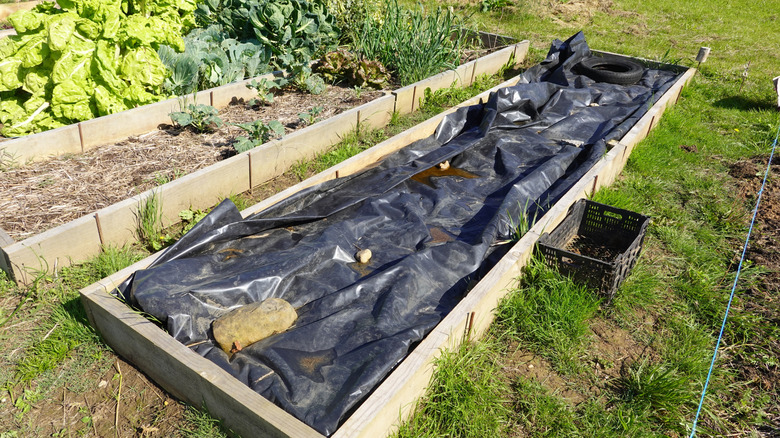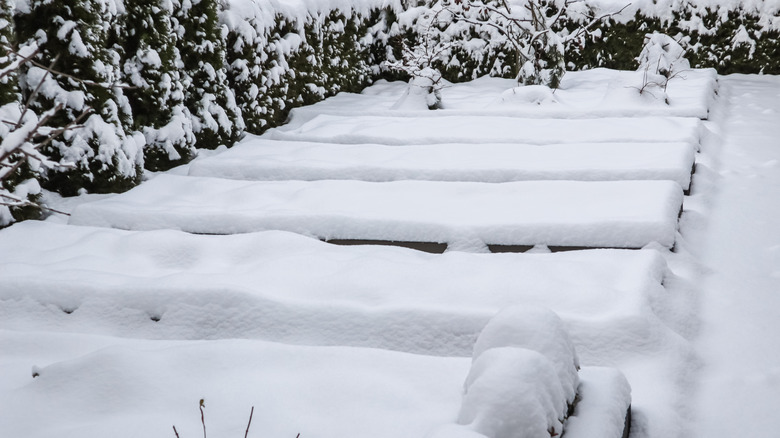Should You Cover Raised Beds In Winter? Here's What All Gardeners Need To Know
Getting your raised beds ready for winter is simple once you know what they actually need — starting with determining whether insulation is necessary. The right approach depends on whether you still have plants growing and what you want from your garden in the colder months. Insulating materials offer different benefits: covers can suppress weeds and shield established perennials, while layers of compost or plastic sheeting help prepare an empty bed for a fresh start once the final frost passes. Essentially, while you technically can leave your raised beds uncovered in the winter, adding some protection will insulate your current crops and make spring gardening prep much easier.
When starting a backyard winter garden, it's not usually suggested to plant anything in beds, as the soil cools quickly. In USDA Hardiness Zones between 3 and 10, though, you can continue to use your raised beds in fall and winter to grow hardier crops. For a raised bed with live plants, your focus will be on protecting the plants. If you just want to make sure the bed is ready for plants when it's time to start your spring garden, covering it is a good option. It makes spring, which is already a busy time for gardeners, a lot easier.
What to use to cover you raised beds in the winter
There are a lot of items you can use to insulate your beds. However, if you are going to overwinter plants in the bed, you'll want materials that allow air and water circulation. Things like cold frames, hoop tunnels, and garden fabric are good options for coverings. Gardening fabric has some issues, though, especially if you live in a wet climate. The fabric doesn't offer as much insulation when wet as when dry.
You can add some mulch or groundcover to help keep the soil a bit warmer as well, but these aren't ideal solutions on their own, as they don't offer enough protection for most zones. Plastics used for greenhouses are a potential option, but they're definitely not the best material for covering your plants to protect them from frost, as they require a lot of maintenance and don't allow airflow.
For overwintering a bed with nothing in it, you have other options. Thick black plastic can be ideal, as the dark color prevents weed growth and helps warm the soil faster come spring. Clear plastic is also a good choice, as it lets light in and holds warmth, which can help plants sprout faster come spring. Tarps, mulch, cardboard, and thermal blankets are also suitable options for empty raised beds.
Prep and upkeep of a covered winter garden bed
You need to put in work if you want to reap the benefits of covering your raised beds during the winter. Generally, this means getting rid of old material that could hold on to diseases, like mulch and leaves, and adding new, fresh items, specifically green material like vegetable debris and your most recent grass clippings. Since
you don't want to skimp on the soil when filling a raised garden bed
, don't be afraid to add a little extra compost. Then, cover it with one of the materials previously discussed. After prepping and covering, you don't need to do much else with your bed until spring comes. The compost and natural materials now have the warmth they need to break down and enrich the soil for spring planting.
For raised beds with plants, the steps are a little more complicated. You can still do the above, but be careful not to bury your plants or put too much material against the stems, as that can cause damage. Unlike with an empty bed, you cannot just set it down and leave it alone. First, you have to make sure the material doesn't touch your plants. If the covering material sits on them, moisture will accumulate, which can lead to frost damage. Sometimes bed covering products include frames to help prevent this. If you are DIYing your own cover, though, you need to add stakes that keep the material from touching the plants.


